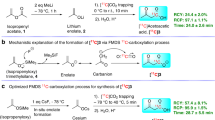Abstract
A procedure for the synthesis of N-succinimidyl 3-iodobenzoate labeled with any iodine isotope ([*I]SIB), which is an agent used in the radioiodination of proteins and peptides, from its tin precursor N-succinimidyl 3-(tri-n-butylstannyl)benzoate (STB) is described. Also included are protocols for the synthesis of an unlabeled standard of SIB and the tin precursor. Radioiododestannylation of STB using tert-butylhydroperoxide as the oxidant gives [*I]SIB in 80% radiochemical yields. The total time for the synthesis of [*I]SIB from STB is ∼95 min. Use of [*I]SIB yields radioiodinated proteins that are considerably more stable in vivo than those radioiodinated by the direct electrophilic method.
This is a preview of subscription content, access via your institution
Access options
Subscribe to this journal
Receive 12 print issues and online access
$259.00 per year
only $21.58 per issue
Buy this article
- Purchase on Springer Link
- Instant access to full article PDF
Prices may be subject to local taxes which are calculated during checkout





Similar content being viewed by others
References
Hunter, R.M. & Greenwood, F.C. Preparation of iodine-131 labelled human growth hormone of high specific activity. Nature 194, 495–496 (1962).
Williams, M.R. & McBride, D. Problems with radiolabelling egg albumin for the Farr ammonium sulphate technique for antibody estimation. J. Immunol. Methods 15, 315–323 (1977).
Nikula, T.K. et al. Impact of the high tyrosine fraction in complementarity determining regions: measured and predicted effects of radioiodination on IgG immunoreactivity. Mol. Immunol. 32, 865–872 (1995).
Olafsen, T., Bruland, O.S., Zalutsky, M.R. & Sandlie, I. Cloning and sequencing of V genes from anti-osteosarcoma monoclonal antibodies TP-1 and TP-3: location of lysine residues and implications for radiolabeling. Nucl. Med. Biol. 22, 765–771 (1995).
Olafsen, T., Bruland, O.S., Zalutsky, M.R. & Sandlie, I. Abundant tyrosine residues in the antigen binding site in anti-osteosarcoma monoclonal antibodies TP-1 and TP-3: application to radiolabeling. Acta Oncol. 35, 297–301 (1996).
Carrasquillo, J.A. In Antibodies in Radiodiagnosis and Therapy (ed. Zalutsky, M.R.) 169 (CRC Press, Boca Raton, Florida, 1988).
Koehrle, J., Auf'mkolk, M., Rokos, H., Hesch, R.D. & Cody, V. Rat liver iodothyronine monodeiodinase. Evaluation of the iodothyronine ligand-binding site. J. Biol. Chem. 261, 11613–11622 (1986).
Wilbur, D.S. Radiohalogenation of proteins: an overview of radionuclides, labeling methods, and reagents for conjugate labeling. Bioconjugate Chem. 3, 433–470 (1992).
Bolton, A.E. & Hunter, W.M. The labelling of proteins to high specific radioactivities by conjugation to a 125I-containing acylating agent. Biochem. J. 133, 529–539 (1973).
Zalutsky, M.R. & Narula, A.S. A method for the radiohalogenation of proteins resulting in decreased thyroid uptake of radioiodine. Appl. Radiat. Isot. 38, 1051–1055 (1987).
Garg, P.K., Archer, G.E., Bigner, D.D. & Zalutsky, M.R. Synthesis of radioiodinated N-succinimidyl iodobenzoate: optimization for use in antibody labelling. Appl. Radiat. Isot. 40, 485–490 (1989).
Koziorowski, J., Henssen, C. & Weinreich, R. A new convenient route to radioiodinated N-succinimidyl 3- and 4-iodobenzoate, two reagents for radioiodination of proteins. Appl. Radiat. Isot. 49, 955–959 (1998).
Breyholz, H.J. et al. C-5-disubstituted barbiturates as potential molecular probes for noninvasive matrix metalloproteinase imaging. J. Med. Chem. 48, 3400–3409 (2005).
Dekker, B. et al. Functional comparison of annexin V analogues labeled indirectly and directly with iodine-124. Nucl. Med. Biol. 32, 403–413 (2005).
Vaidyanathan, G. & Zalutsky, M.R. Protein radiohalogenation: observations on the design of N-succinimidyl ester acylation agents. Bioconjugate Chem. 1, 269–273 (1990).
Zalutsky, M.R. & Narula, A.S. Radiohalogenation of a monoclonal antibody using an N-succinimidyl 3-(tri-n-butylstannyl)benzoate intermediate. Cancer Res. 48, 1446–1450 (1988).
Zalutsky, M.R., Noska, M.A., Colapinto, E.V., Garg, P.K. & Bigner, D.D. Enhanced tumor localization and in vivo stability of a monoclonal antibody radioiodinated using N-succinimidyl 3-(tri-n-butylstannyl)benzoate. Cancer Res. 49, 5543–5549 (1989).
Acknowledgements
The authors want to thank D. J. Affleck and K. L. Alston for help with the experimental details. This work was supported by the National Institutes of Health.
Author information
Authors and Affiliations
Corresponding authors
Ethics declarations
Competing interests
The authors declare no competing financial interests.
Rights and permissions
About this article
Cite this article
Vaidyanathan, G., Zalutsky, M. Preparation of N-succinimidyl 3-[*I]iodobenzoate: an agent for the indirect radioiodination of proteins. Nat Protoc 1, 707–713 (2006). https://doi.org/10.1038/nprot.2006.99
Published:
Issue Date:
DOI: https://doi.org/10.1038/nprot.2006.99
This article is cited by
-
Targeted radionuclide therapy with astatine-211: Oxidative dehalogenation of astatobenzoate conjugates
Scientific Reports (2017)
-
Synthesis and preclinical evaluation of DOTAGA-conjugated PSMA ligands for functional imaging and endoradiotherapy of prostate cancer
EJNMMI Research (2014)
-
Properties of PEI-based Polyplex Nanoparticles That Correlate With Their Transfection Efficacy
Molecular Therapy (2011)
-
Synthesis and preliminary evaluation of a novel 125I-labeled T140 analog for quantitation of CXCR4 expression
Journal of Radioanalytical and Nuclear Chemistry (2010)
-
Synthesis and pharmacological characterization of [125I]MRS1898, a high-affinity, selective radioligand for the rat A3 adenosine receptor
Purinergic Signalling (2009)
Comments
By submitting a comment you agree to abide by our Terms and Community Guidelines. If you find something abusive or that does not comply with our terms or guidelines please flag it as inappropriate.



